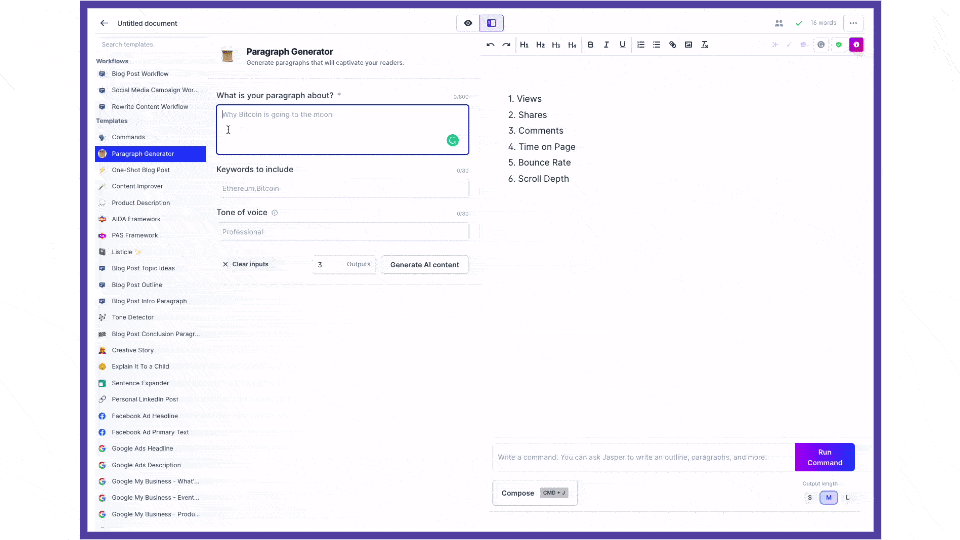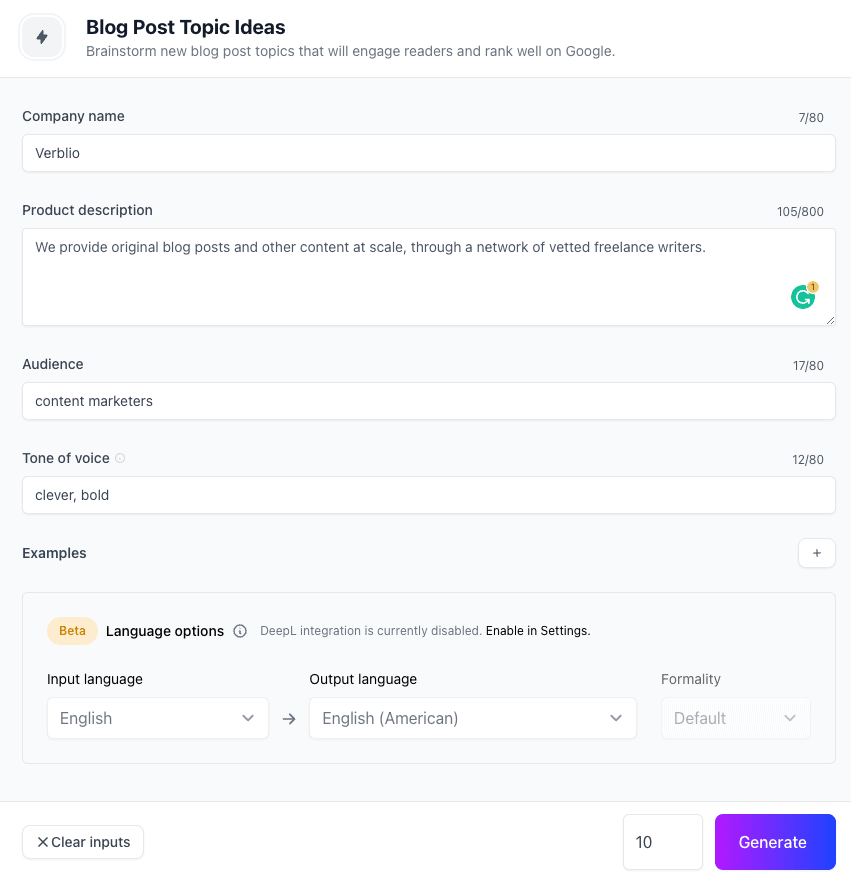Before ChatGPT came along and turned everyone and their mother into AI armchair experts, Jasper was devouring the AI writing tool market. (It did just raise $125M in the fall of 2022, so it’s probably still doing okay—but then again, they are blowing insane amounts of money on their affiliate program by offering 30% LTV for referrals, so maybe not. In totally unrelated news, you should use our affiliate link if you want to give Jasper a spin.)
My company, Verblio, is in the content creation business, and I’m a former writer turned content marketer. As a result, I’ve been exploring all the latest AI writing tools and technology out of both professional interest and personal curiosity. AI can do some extremely cool stuff, but for every truly breakthrough achievement, there’s also an overhyped shuckster slapping “AI” on its website and giving robots everywhere a bad name.
Where does Jasper fall on that spectrum? Well, it’s not a shuckster. It’s not a human-level writer either, though.
In this Jasper AI review, we’ll give an overview of how it works, its pricing structure, some examples, and our general impressions:
- What is Jasper and how does it work?
- Is Jasper AI any good?
- How much is Jasper AI?
- Jasper examples
- Tips for using Jasper
- Jasper alternatives
- Notes on the One-Shot Blog Post feature
Please note this review contains affiliate links. This means, at no cost to you, we may earn a commission if you click a link and purchase services from Jasper.
TL;DR
Like any tool, Jasper is only as good as the person wielding it. If you’re a good writer and know how to use it, Jasper will be able to help you create some types of content more efficiently.
If you’re a shitty writer, Jasper isn’t going to help you be a better writer—it’s just going to help you be a faster, more prolific shitty writer.
Jasper also has a learning curve. Regardless of your writing ability, figuring out how to use the tool effectively will take some time and effort. The Jasper team recognizes this, which is why they so heavily incentivize going through their “Jasper 101” education.

Kudos to them for this approach. AI writing technology simply isn’t good enough to be left unattended, but it can be powerful when combined with a good writer who knows how and when to leverage it.
That’s the takeaway for all existing AI writing tools, including Jasper: The people who should be thinking about using them right now are writers. These tools are not yet good enough to replace writers.
So, if you’re a content team lead reading this and dreaming about firing that guy Bob who writes for you but seems far more interested in your office’s free nitro on tap—sorry, you shouldn’t kick Bob to the curb just yet. If you are a writer and are willing to put in the time to learn how to use Jasper effectively (and know the pitfalls to watch out for) you may find it very useful in upping your productivity.
Either way, read on. I’ve been playing around with Jasper a ton over the last few months, and publishing something is the only way I can justify spending all that time and I’m excited to share findings, examples, and some key learnings. Knowledge is power.
What is Jasper and how does it work?
Jasper is a tool that uses GPT-3 to generate content, including social media posts, ad copy, blog posts, emails, and more.
If that definition just raised more questions for you, check out our overview of GPT-3. (TL;DR: GPT-3 is a machine learning model from OpenAI that has been trained on an enormous dataset of online content to be able to generate human-sounding text. It’s the tech behind nearly every AI writing tool on the market today.)
How it works
The Jasper interface is built around templates. These include things like Paragraph Generator, Product Description, Blog Post Outline, Google Ads Headline, and more.

It also has “recipes,” which string together different templates.For example, the “Write a Blog Post” recipe includes the following steps:
- Write a brief for a given topic
- Write blog title ideas
- Write an introduction
- Write a blog outline
- Write about outline item #1
- Write about outline item #2
- Write about outline item #3
- Write a conclusion
There’s a template for each step, each of which you could use on your own not as part of a recipe. For example, if you already have a title and outline, you could use the Blog Post Intro Paragraph template on its own to generate the first paragraph, and then use the Paragraph Generator template for the subsequent body paragraphs, based on your own outline.
Each template asks you for some information, like your audience and tone of voice. After entering that information, you hit ‘Generate,” and Jasper writes the content you’re looking for, whether that’s topic ideas, outlines, or actual blog content.
Here’s what that looks like in action, with the Blog Post Outline template:

If I don’t like any of those, I can generate more options. If I do like one, I can then open it in a doc. From there, I can continue to use the templates to have Jasper generate more text for me…

…or I can use Jasper’s “Compose” command to have it write more text directly in the doc, wherever my cursor is.

We’ll show more examples of some of its different templates later.
Jasper AI review: Is it any good?
Whether or not Jasper is any good depends completely on your expectations. I’ve already said the people who should be thinking about using these tools are writers, but just to reiterate: If your expectation is that getting a Jasper subscription will enable you to fire your in-house writers or freelancers and still publish good content—lol. No.
But okay, let’s say you’re a writer. What should your expectations for Jasper be?
When it comes to getting words on a page and producing general, “filler” text, Jasper is quite good. However, none of what it produces should be published without review and fact-checking. (More on that in a sec.) Also, if you rely on it to produce a long-form blog post without putting in time yourself on the structure and key sections, that blog post will be very generic and won’t say anything original or make any convincing argument.
In a nutshell, you still need to be putting the “thought” and originality into your content, while Jasper can help fill out the edges and save you from writer’s block.
Depending on the style of stuff you write and your current workflow, Jasper will be able to help to a greater or lesser degree. For example, if you write very lean content that walks users through the steps in a technical process, or if you write highly original thought leadership based on the very latest advances and data in your industry, Jasper will be able to help you a lot less than if you write top-of-funnel B2C blog posts.
No matter what you’re writing, though, there are two major risks to be aware of with anything Jasper produces:
- It might be straight-up false, e.g. it might say 7 times 6 is 28.
- It might contradict itself. In one paragraph it might say X tool is the cheapest, and later say Y tool is the cheapest.
If these seem like major problems for a writing tool—or surprising problems for something called “Artificial Intelligence”—yeah, it’s a bit ironic. These weaknesses stem from the GPT-3 model Jasper is built on, which operates based on the patterns of how words are used and not their actual meaning. (It’s also worth remembering that these are the fundamental problems of any AI writing tools right now, not just Jasper.)
If you’re a business or agency scaling quickly and looking for plug-and-play content, don’t forget to calculate time spent editing AI content so that it’s usable.
Final verdict: If you’re a good writer AND you’re aware of the tech’s weaknesses AND you accept that you’ll need to review all your content for accuracy and consistency, Jasper can be a helpful tool for keeping up your productivity and momentum as you write.
How much is Jasper AI?
As of February 2023, Jasper’s pricing is very simple. Unless you need an enterprise account with custom pricing, your only option is Boss Mode beginning at $59 per month.
(Sidenote: This is the price for monthly billing. There is a discount if you sign up for an annual plan, but at the rate the AI industry changes, I would be very hesitant to sign an annual agreement with any tool right now.)
In addition to paying for the plan, you also pay for monthly word credits. Boss Mode includes 50,000 credits at no additional charge.

Your word count options are fairly limited, though:
- 50,000 words: included at $59/month
- 100,000 words: $99/month total
- 300,000 words: $279/month total
- 700,000 words: $600/month total
- More than 700,000 words: custom pricing
These increments mean that if you need more than 100,000 words but less than 300,000—or between 300,000 and 700,000—you’ll be stuck paying for a lot more words than you actually need.
Does Jasper have a free trial?
Jasper does offer a 5-day free trial with 10,000 credits—but you have to sign up for a plan and give them your credit card information anyway. So, it’s less of a free trial and more of a, “You have five days to get your money back if you hate it (and if you remember to email us in time to get a refund)” sort of thing.
Credits and outputs
You know how I said 60,000 credits equals 40 blog posts at 1,500 words apiece? Well, consuming credits with Jasper isn’t quite as simple as saying “I need X number of 1500-word blog posts per month, therefore I need X times 1500 credits.”
Here’s why:
Any time you use a Jasper template, you get to choose how many outputs you want it to generate. For example, if you’re using the Blog Post Conclusion Paragraph template, you can choose how many different conclusions you want it to write for the same article.
The value of this is obvious for a template like Blog Post Topic Ideas, where you’d want more than one idea to choose from. Why would you want it to write more than one conclusion paragraph for the same article, though?
Because one of the most fascinating and frustrating aspects of GPT-3 (and the AI writing tools built on top of it) is its inconsistency.
This means you can give the AI the same prompt ten times, and you’ll get a different output each time: Five might be mediocre, three might be terrible, and two will be great.
The most common way that AI tools try to address this inconsistency is by generating multiple options for you to choose from, in the hope that one of the three or five or seven choices will work. With Jasper, you can choose how many choices you want to see.
Does that mean you should set it to 100 outputs to give yourself the best chance of getting back something great? Nope, because each output costs you credits.If you’re generating 10 outputs for each prompt, for example, you’re going to eat up your credits 10x faster than if you were only generating one output per prompt.
Generally speaking, I’d recommend using these output numbers, based on what you’re creating:
| Content type | Number of Outputs |
| Short: headline options, topic ideas | ~10 |
| Medium: single paragraphs, product descriptions | 3 to 5 |
| Long: full blog post | 1 to 2 |
Being mindful of the number of outputs you’re using is especially important because Jasper doesn’t show you your credit usage anywhere except in your account page. That means you can’t conveniently monitor it as you use tools, and instead you have to remember to go check your remaining balance periodically.
By default, your account will be automatically upgraded when you go over your credit limit, meaning higher billing charges. You can turn that setting off, in which case when you max out your credits, you won’t be able to generate anything else until the next monthly billing cycle starts and your credit limit resets.
Jasper examples
Want to see the quality of Jasper’s output for yourself? I walk through examples from a few of its templates below, using topics from our own (human-written) blog. If you’re curious about a different template or want to hear how Jasper does with topics from another industry, shoot me an email at megan@verblio.com.
Content Summarizer
Like the doc interface, the Content Summarizer template is one of a few tools that are only available in Boss Mode. I used a recent article I wrote on GPT-3 and metaphors as an inputand asked it for three outputs. (For context, that article showed what GPT-3 wrote when I asked for a blog post comparing video conferencing platforms to ice cream flavors, which led into a larger discussion around human creativity vs. machine creativity, and why things like humor are hard for AI tools.)
Here’s what Jasper returned:

The first summary is pretty good. I could use that somewhere to summarize the article. The other two, unfortunately, both include at least one bullet point from the GPT-3 example I referenced in the article, the content of which is both irrelevant to the overall theme and nonsensical (which was the entire point of the article.)
Similar to what I said about factual accuracy and logical consistency, you can see that Jasper is summarizing based on the words that are present in the article, without actually understanding what is being said (and thus, without understanding what is actually a main point versus what is an example or an aside.)
If you run it enough times, though, odds are good that you will get something usable from the Summarizer template.
Blog Post Topic Ideas
I also tried the Blog Post Topic Ideas template (available in both Starter and Boss Mode).

Here are the ten ideas it returned:
- The art of persuasion: crafting persuasive content that hooks readers and ranks well on Google
- The power of user-generated content and why it is so important for your marketing strategy
- How to use original content to stand out in crowded online spaces
- “10 Ways to Hook Readers and Rank on Google: A Content Marketer’s Guide”
- “5 Simple Ways to Hook Readers and Boost Your Rankings on Google”
- The art of writing content that hooks readers’ attention and ranks well on Google
- 10 foolproof tips for generating blog post ideas that pack a punch
- The evolution of content marketing over the past decade: This post would hook readers’ attention by exploring how and why content marketing strategies have changed over time, and what this means for modern marketers.
- Build engaging blog posts that hook readers’ attention – Ways to create compelling content that ranks well on Google
- “How to Hook Your Audience from the First Line: 10 Techniques”
I have a few observations on those ideas:
- Repetitiveness: 7 of the 10 talk about “hooking” — and numbers 4 and 5, in particular, are almost identical.
- Inconsistency: Number 8 includes a brief summary of what the article would cover, while the other ideas are only titles. Also, a few use quotation marks around the title, while most don’t.
- Lack of originality: These are all very generic ideas.
Let’s give this template another shot, though, and this time we’ll include a few titles of posts we’ve recently published as examples for Jasper to use.

Here were the results, after providing those examples:
- Creating Shareable Content that Keeps Readers Engaged
- 10 No-Fail Tactics for Capturing and Keeping Audience Attention
- The Power of Keyword Research for Capturing Attention and Ranking on Google
- The Top Trends in Content Marketing for 2019
- The New Rules of Content Marketing: Using Psychology to Send Traffic Soaring
- Personalization Strategies for Engaging Audiences
- Creating Catchy SEO-Driven Posts on a Tight Budget
- Using Content Marketing to Boost Social Engagement
- Harnessing Machine Learning for Better Content Marketing Analytics
- The Art and Science of Blog Writing: Setting SMART KPIs & Tips to Boost Engagement
These topics are better and more consistent. They also include some new topics that the original ten didn’t, like talking about metrics and research. (Of course, you will get different results every time you use a template, so it’s hard to definitively say which differences are a result of the extra input.) Overall, though, I feel confident that including examples improved the results, which is one general principle of working with AI writing tools.
(FWIW, though, while these results are fine, I can say that I’ve consistently gotten better, more original topic ideas from using GPT-3 directly myself ????♀️)
Tips for using Jasper
If you’re planning to give Jasper a try, here are a few guiding principles for getting the most out of it:
- Use it for short-form content—or for adding a sentence or two at a time to long-form content—rather than for writing a full blog post.
- For short-form content, generate several results and choose the best one.
- When possible, give it examples of what you’re looking for.
- Confirm any factual claims it makes yourself (especially if numbers are involved!)
- Expect ideas and inspiration, not publish-ready content.
- Know what you’re writing before you begin using it.
- Watch out for repetition or contradictions in what it writes.
Jasper alternatives
If you’re curious about any of the other AI writing tools out there, here are a few others I’ve checked out.
A quick note before we dive into these alternatives—they should all be viewed as tools for writers. Without a writer who knows how to use the tool, disappointment will abound. So, if you’re a marketer or team lead looking for content that’s ready to use, consider AI content writing services — solutions that leverage AI content, but keep a human in control for prompt engineering, editing, fact-checking and injecting the type of stuff only humans can (hint—we’ve built this).
In general, these five are roughly similar to Jasper with most of the same functionality. And, most importantly, they’re all built atop GPT-3, which means the underlying tech (with all its limitations and shortcomings) is the same. The only differences are in how they help you interact with GPT-3 and the interface they provide:
All of the above use different templates for different types of content, like Jasper.
There’s another set of tools that don’t use templates and are designed to be used in-line, while you’re writing. A couple of the big ones in this space are ChibiAI and Lex. Generally, these are marketed more as “assisting” your writing, versus Jasper and co, which you can have do more of the writing themselves.
And finally, there’s a set of AI content writers you should avoid at all costs, with Article Forge and Kafkai meriting a special dishonorable mention for extremely poor writing.
If you want to go deeper on AI content writing tools? Read our roundup of the best AI content writing services.
Notes on the One-Shot Blog Post
If you’re still reading and curious, here’s a final example of Jasper’s quality:
One of their newest and most-hyped templates is the One-Shot Blog Post. I gave it a spin, with the topic of “content marketing KPIs” and a friendly tone of voice for an audience of digital marketers.

Here’s what Jasper gave me:
Blog Title: What are KPIs in Content Marketing?
Blog Introduction: If you’re a digital marketer, then you know that KPIs (Key Performance Indicators) are an essential part of any successful marketing campaign. But what exactly are they? In short, KPIs are measurable values that help you track and assess the performance of your marketing campaigns.
There are a lot of different KPIs out there, but in this blog post, we’re going to focus on three of the most important ones for content marketing: traffic, engagement, and conversion.
Blog Body:
Traffic
One of the most important things to track when it comes to your content marketing campaign is traffic. After all, if nobody is seeing your content, then it’s not going to be very effective! There are a few different ways to measure traffic, but one of the most common is pageviews.
You can also track things like unique visitors and time on page to get a more detailed picture of how your content is performing. If you see a sudden spike in traffic after publishing a new piece of content, that’s a good sign that people are engaging with it!
Engagement
Engagement is another important metric to track when it comes to your content marketing campaign. This one can be a little bit more difficult to measure than traffic, but there are still some good ways to do it.
One way to measure engagement is by looking at comments and social shares. If people are taking the time to comment on your blog post or share it on social media, that’s a good sign that they’re engaged with your content. You can also track things like time on page and bounce rate to get an idea of how engaged people are with your content.
Conversion
The final KPI we’re going to talk about is conversion. This one is important because it measures how effective your content is at achieving its goals. If you’re selling products or services, then you’ll want to track how many people who see your content go on to make a purchase.
You can also track conversions for other goals, like newsletter signups or downloads. The important thing is to make sure that you’re measuring something that’s relevant to your business goals.
Conclusion:
These are just three of the most important KPIs for content marketing campaigns! Keep track of these metrics and you’ll be well on your way to success. Thanks for reading!
Overall, this article is fine.
One thing that impressed me, based on my experience with GPT-3 and other AI tools, is the bit under Engagement that says “This one can be a little bit more difficult to measure than traffic, but there are still some good ways to do it.” It’s accurately referring to the section I just read and, as a reader, makes me feel like this was written according to a logical structure rather than by just stringing random buzzword-y sentences together, which is how AI content can often sound. I’m curious whether that happened by chance, or if the prompts Jasper is using with the OpenAI API are intentionally doing something to include more transition-y statements and sound more structured.
When we consider the information itself, though, this content is very general and entry-level. Unless you know absolutely nothing about content marketing before you read it, you’re probably not going to learn anything. It doesn’t give any insight into processes for measuring these metrics or nuances in understanding them, nor does it address when certain KPIs might be more applicable than others.
(For comparison, here’s our post on the same topic of content marketing KPIs, written by a human. What I like most about our post is that it’s specific and actionable. It gives more context for the metrics by tying them to the different funnel stages, in addition to telling you exactly where in Google Analytics you can find your consumption metrics.)
A good writer could use Jasper’s one-shot blog post as a starting point and improve on it, but a lot of the weakness is inherent in the structure itself—in the general headings of Traffic, Engagement, and Conversion. Unless they significantly rewrote and restructured it, the amount of information gain they’re going to be able to inject into the article is limited.
Overall, I’d steer away from this template and instead build an article with Jasper piece-wise, as the “Write a Blog Post” recipe I previously mentioned does.
It’s for exactly this reason, though, that the people who should be using Jasper are writers. Non-writers don’t have the expertise to help guide the AI through the creation process, whether by writing a killer outline or by editing the introductory paragraph to “seed” the AI with an appropriate tone and style. Instead, they’ll end up with a very generic, lackluster piece of writing that provides no value to either the business or the audience.
Editor’s note: This article was originally published on November 4th, 2022, but was updated on February 8, 2023, to reflect Jasper’s current plans and pricing and the fact that ChatGPT has blown it out of the water.



